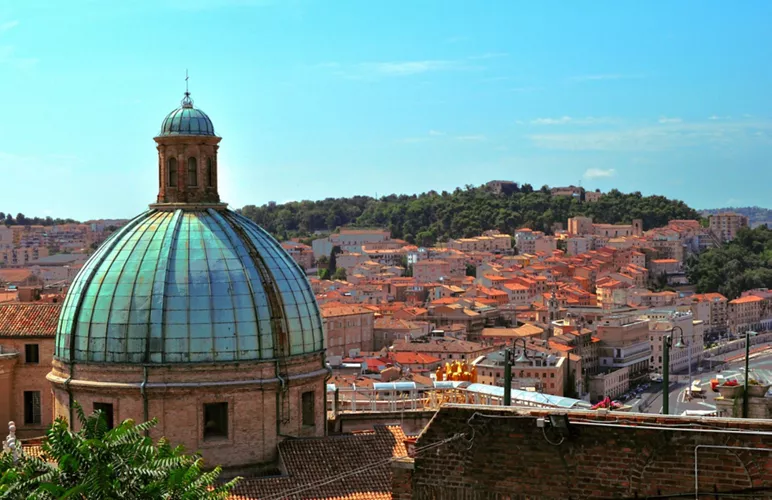This content was automatically translated. View the original text.

Overview
Ancona: sentinel on the Adriatic Sea
At the northern end of the Conero promontory, the city of Ancona stands on a natural harbour dominating a wide stretch of the Adriatic coast.
Its historical centre, a few metres from the ferry embarkation point, holds art treasures, beautiful buildings and that liveliness that only port cities possess. To be discovered on foot, from the port to the Duomo, to the Cardeto park and the Passetto beach, where Ancona's inhabitants go to enjoy the sea, Ancona is a city that knows how to amaze.
A stroll through historical sights and the sea view
Upon arrival in Ancona, by car or from the station, one of the first monuments to attract attention is the pentagonal building at the entrance to the old port, the so-called Mole Vanvitelliana, named after its architect Luigi Vanvitelli, built as a lazaret for quarantine of people and goods coming from overseas, now converted to a space for cultural events. Continuing towards the maritime station, one can see the 15th-century Palazzo Benincasa and the Loggia dei Mercanti, the most important secular building in flamboyant Venetian Gothic style. Entering the historical centre, along Viale Mazzini, you can see the Renaissance Fontana del Calamo or Tredici Cannelle, with its bronze masks.
Heading up towards the acropolis, after visiting the Mercato delle erbe (Herb Market), Art Nouveau structure in iron and cast iron, you will see the beautiful Church of Gesù, also by Vanvitelli, overlooking the sea. Next, the Roman Amphitheatre, rediscovered in the 19th century, and the Cathedral of St Ciriaco, Roman-Gothic basilica built on the remains of a temple dedicated to Venus and an early Christian basilica: spectacularly dominating the city and port. If you walk down towards the old harbour you can see the Arch of Trajan from the 2nd century AD and the Clementine Arch, an 18th-century work by Vanvitelli.
To the south, Cardeto Park a green area on the hill of the same name where you can walk with the sea on the horizon: inside you will find the old lighthouse and the suggestive monumental Jewish cemetery, among the largest in Europe.
Must-see museums in Ancona
The National Archaeological Museum of Marche exhibits the largest collection of artefacts in the entire region from the Palaeolithic to the Classical period, where visiting the 16th-century Palazzo Ferretti with its rich decorations and splendid views of the port and bay of Ancona is possible.
Ancona's history is reconstructed in the City Museum with documents, exhibits, models, educational panels, maps and videos. The Pinacoteca Comunale in Palazzo Bosdari exhibits masterpieces such as Titian's Gozzi Altarpiece, his first autograph work, Lorenzo Lotto's Sacred Conversation, and works by Sebastiano Del Piombo.
A unique experience is offered by the Omero Tactile Museum, housed in the Mole Vanvitelliana, offering the rare opportunity to learn about art through touch, thanks to life-size plaster casts of sculptures, models of famous monuments and archaeological finds.
Ancona’s beaches
The best-loved and most popular beach for the people of Ancona is Passetto, a tongue of sand under the green promontory, which has the peculiarity of including more than 500 “caves” dug into the rock from the 19th century until the 1960s by locals. The reason? To store small boats and fishing gear. Each “cave” is enclosed, like a garage, with salvaged material of various kinds and colours: a picturesque ensemble. Less frequented, because access is difficult, is the Scalaccia beach at Pietralacroce. It is reached by steps, not always easy. Once there, however, the effort will be amply rewarded.
Also beautiful and wild is the Mezzavalle beach, continuation of the Portonovo bay, of sand and gravel: reached by two steep paths to be tackled with suitable boots.
What to eat in Ancona
Among the most typical dishes of Ancona cuisine is stockfish or dried codfish cooked with potatoes, tomatoes and herbs. If you are wondering why cod – a fish from northern Europe – the answer lies in the frequency of trade contacts between Ancona and northern European countries.
Here, as in many other towns in the Marche, we eat brodetto which is a typical fish soup, and the wild mosciolo of Portonovo, a type of mussel that lives on the Conero coast, recognised as a Slow Food presidium.